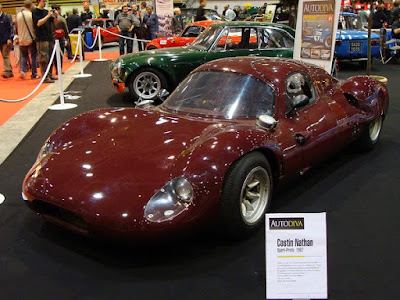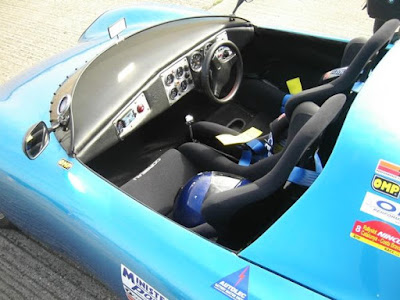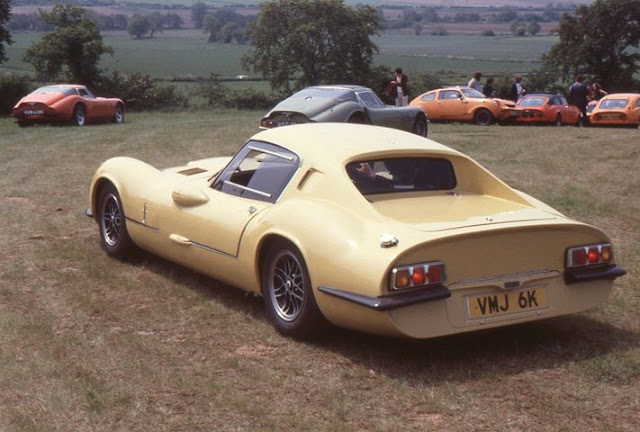The Art and Science of Frank Costin
 |
| The Costin Amigo, 1 of 8 made |
As the development of aviation in the early 20th century accelerated, so did the scientific theory and understanding of aerodynamics. The war years raised the stakes even higher as aircraft technology grew in leaps and bounds. Among the pioneers of the field was an Englishman named Frank Costin.
 |
| Francis Albert Costin (b. 1920 - d. 1995) |
Costin was born in Middlesex, England, in 1920. In his youth, he was an Olympic-level competitive swimmer and developed a passion for mathematics at an early age. As a young adult, he studied for a BSc at Acton Tech before the War intervened. When those events unfolded, he enrolled as a fitter at General Aircraft where his talents were quickly noticed and led to a position in the drawing office. He demonstrated a high degree of proficiency in wing and airfoil design.
Costin's aircraft experience following World War 2 included working with Supermarine, Percival and de Havilland, including an important spell as an airframe flight-test engineer in charge of the experimental department at their Chester division. However, by the late 1950's the industry was in decline and by 1958, Costin had moved on.
 |
| The Costin designed Lotus 11 |
Like many young men in post-war England, he got involved with motorsports during the 1950's. Applying his specialized knowledge, he started working on the design of such machines. Working with fellow de Havilland engineer, Colin Chapman of the newly formed Lotus company, he created streamlined bodies for several of their early racecars including the iconic Lotus 11. The cars were very successful, cementing his reputation as a master aerodynamicist among the sport's cognoscenti, though he received little public credit for his efforts.
His designs weren't always "pretty", in the conventional sense, but they were always rooted in sound aerodynamic theory. His work emphasized low drag, straight-line stability, and the clever use of intakes and vents to take advantage of the pressure zones that were a side-effect of air moving over a given shape. He was famously quoted as saying, "If a car wins, it becomes beautiful". He cared little for aesthetics, taking a purely utilitarian approach to car body design
.
.
 |
| The Vanwall Gran Prix racer designed by Frank Costin and Colin Chapman |
A perfect exemplar of this philosophy was the Vanwall Grand Prix car, a car that started out a mess. After a poor showing, the industrialist Tony Vandervell's team consulted with Costin, along with Colin Chapman, to redesign the car. Due to its general configuration and packaging of the mechanicals, this proved to be a challenging proposition.
While Chapman set about sorting out a new chassis, Costin worked on an aerodynamic shell for the car. With its tall motor and elevated driver position, due to the placement of the transmission, the original car had a massive frontal surface area. To rectify these shortcomings, a slippery shape not unlike the fuselage of an air racer was employed with an elongated nose that terminated in a tight ellipsoid intake and high tail with a tall headrest faired into the body. The modifications, both mechanical and aerodynamic proved quite effective.
Leaving little to chance Vandervell frequently hired high profile drivers like Stirling Moss and Tony Brooks. The cars showed considerable potential, but mechanical issues frequently let the cars down. Nonetheless, Moss was able to score Vanwall's first major victory in the Silverstone International Trophy series. By the start of the 1957 season the cars were almost as reliable as they were fast. The all-star team of drivers was now hired full-time and talented young-gun Stuart Lewis-Evans was hired as the third driver.
With the various teething problems ironed out, a glorious period for Vanwall started. At Aintree, Moss took Vanwall's maiden Grand Prix victory, the first for an all British entry for 34 years! Moss went on to score two more wins that season, including one at Monza, much to the embarrassment of the local Ferrari and Maserati teams. After Maserati's retirement, the 1958 season was very much a Ferrari vs. Vanwall battle.
Ferrari's newly developed 246 Dino was very fast in a straight line, but it was beaten by the Vanwall on more twisty tracks. Moss repeated his 1957 feat and won three Grands Prix, and Brooks added another three to Vanwall's tally. However, Moss came a single painful point short of the driver's title, won by Ferrari's Mike Hawthorn, but Vanwall did comfortably win the very first constructor's cup.
This time Frank Costin's work had won wide acclaim and to this day the Vanwall grand prix car is considered a masterpiece of racecar design. The recognition gained him a fair amount of work too, as it turned out. He went on to design bodies for the Lister-Jaguar, the record-breaking Speedwell Austin-Healey Sprite, a special Lotus Elan for Moss, a nose for the TVR, studies for Ford, and even a low-drag body for the British four-man bobsledding team.
The following Costin quote makes for a nice segue into the next phase of his career...
"My religion is engineering but I’ve often dealt with people whose religion is money and there have been conflicts when each of us has been true to his own creed."
After a less than amicable split with Lister, Costin decided to produce his own car and partnered with racecar builder Jem Marsh to form Marcos, which was a combining of their respective surnames. The pair gathered a team and set up shop in the north of Wales.
"My religion is engineering but I’ve often dealt with people whose religion is money and there have been conflicts when each of us has been true to his own creed."
After a less than amicable split with Lister, Costin decided to produce his own car and partnered with racecar builder Jem Marsh to form Marcos, which was a combining of their respective surnames. The pair gathered a team and set up shop in the north of Wales.
 |
| Costin with the wooden chassis of the Marcos Xylon |
He explains the thinking behind their initial car as follows, "I'd always admired the concept of the Lotus Seven but the early ones let in water and were prone to corrosion and frame failure. I was approaching forty and wanted something like a Seven but dry, with a long chassis life. It had to be light, stiff and easy to build with the tools I had at my disposal. Having examined all the possibilities, I found to my horror that it would have to be made of wood. Technically there was no problem, for we'd used wood a lot in the aircraft industry, but I was afraid of what people would say. Finally I thought, 'Blow what people say. If it wins it will be accepted. They'll only sneer if it doesn't.' It won first time out."
The car Costin came up with was called the "Xylon". It had gullwing doors, a windscreen in four panels, and was nicknamed the "Ugly Duckling". Aimed at 750 Motor Club events, a total of nine were built in 1959 and 1960. For production the body was made less radical but initially retained the gullwing doors. It was powered by a choice of Ford engines varying from 997 cc to 1498 cc and had Standard 10 and Triumph Herald steering and suspension components. Thirty-nine were made up to 1963.
Despite its ungainly appearance it was a potent racecar and has the distinction of being Sir Jackie Stewart's first mount at the beginning of that illustrious career. It was very innovative with its aforementioned plywood "monococque" chassis, which was really a stressed-skin hull comprising a number of torsion boxes, and unconventional looking aerodynamics. This type of construction had been used in aircraft production for decades, but was new to automotive engineering. It was a method Costin continued to develop throughout the remainder of his working life.
In 1965 Roger Nathan, a noted racecar driver and tuning shop owner, commissioned Costin to partake in a joint project. It all started with a visit to the workshop of fellow Lotus alumnus Willie Griffiths, who was Colin Chapman's chief mechanic. A tuned, 1 liter Hillman Imp motor had caught Frank's eye because of its light weight and surprising power output. It produced nearly 100bhp bhp and yet, with a Jack Knight gearbox attached, weighed only 230 lb.
Upon hearing of Costin's reaction to the motor, Roger approached him about the endeavor.
Upon hearing of Costin's reaction to the motor, Roger approached him about the endeavor.
The result was a very light and aerodynamically slippery wooden car along the lines of the Lotus 23. Some potential customers may, however, have been put off by the seemingly fragile subframes but they had been correctly stressed and never gave trouble. Ready to race, the car weighed just 860 lb. Nathan took six class wins and six lap records in 1966.
A GT version was commissioned, which featured the bulbous door hinges seen later on the Amigo. Door hinges on a wooden monocoque presented all manner of problems to Costin, but the most reliable, easily maintained and adjusted, proved to be a pair of exterior mounts. These hinges were covered by bulges in the bodywork, derived from the design of the Vanwall’s mirror fairings, and concealed ductwork to vent air into the cabin.
Fourteen lap records and two national championships followed in 1967/8 but only about a dozen examples of each car were built. The design was developed further as the FVA-powered “Astra”. Costin eventually lost interest in the project and turned his attention elsewhere.
Having parted ways with Jem Marsh and Marcos, Costin decided to produce a road car entirely of his own conception. This was to be the "Amigo" and it was his most sophisticated feat of design yet. Designed in 1968, It employed an evolved form of wooden stressed-skin hull chassis with an incredible degree of rigidity. He designed the tub around six torsion boxes. Three ran fore and aft and consisted of deep sills on either side of the cockpit and the transmission tunnel. The sills were strengthened by internal bulkheads, or ribs, placed at 12″ intervals. Three more torsion boxes ran transverse to the structure, one forming the engine bay, the next the cockpit, and the last the trunk and rear suspension housing. A fully enclosed stressed undertray tied all of the boxes together.
The skin consisted of marine plywood and spruce. The internal bulkhead, local reinforcement for suspension pickups, and all major stressed structures were constructed of non-marine plywood and Parana pine. All bonds were made with a synthetic resin adhesive called Aerolite, which required minimal clamping pressure to set, because of its excellent gap-filling properties. Thus, the production jigs were maintained by simple spring pressure or C clamps.
The chassis featured built-in seats, which were essentially multi-curved sheets of plywood. They were internally boxed and glued to the primary structure as well, which contributed to its overall rigidity. To accommodate a given driver, the steering wheel and pedal group were movable as a unit, fore and aft. They were mounted on a tracked assembly that was spring loaded towards the rear and was operated via a pull knob on the dash.
The front-hinged hood and coupe top were constructed of fiberglass. A thin fiberglass veneer was also applied to all of the exterior wood surfaces of the body and doors in order to produce a smooth enough surface for accepting a top-quality paint job.
 |
| The Costin Amigo (Note the teardrop shapes where the door hinges are faired into the bodyside) |
Door hinges on a wooden monocoque presented all manner of problems to Costin, but the most reliable, easily maintained and adjusted, proved to be a pair of exterior mounts. These were paired with low drag covers, the top ones incorporating cockpit air intakes that fed air to vents above the door sills.
It employed an advanced, low drag body with a "coke bottle" shape that enhanced straight-line stability. No detail was ignored and even the mirrors were wind-tunnel tested. The ultra lightweight construction and streamlined shape of the Amigo helped it achieve more than 130mph, despite using a basic 2.0 liter Vauxhall motor. Its rigidity and low center of gravity made for great handling too.
Sadly only 8 were made because the financial backing that Costin secured to cover the construction of prototypes could not be extended to permit the car to go into production and so the project ended.
His next major design, the Costin Sports Roadster, was a lightweight mid-engine sports car. It was intended for initial launch in the mid 1990s. A prototype test bed chassis mule was finished in 1991 at Costin Ltd in Wales. Another car was finished in the mid nineties with revised body styling but was not initially road registered. In total 6 chassis were constructed and 2 bodies. Unfortunately the company, Costin Ltd., went into liquidation following a number of unsuccessful attempts to find funding for the venture.
In his later years Costin continued work as a consultant, modifying the body of a Formula Ford single-seater racing car, for enhanced performance, and creating his own ultra-light Dragonfly glider in conjunction with his old friend Keith Duckworth. Duckworth, it should be noted was a longtime business partner of Frank's brother, Mike Costin. Together, they founded Cosworth Engineering.
Speaking humorously of his brother, he told a journalist, "Young Mike has said of me, 'Frank's a brilliant engineer but a commercial catastrophe'..." Costin could not be said to have taken himself too seriously. However, his attitude towards his craft was another matter. His professional demeanor was described by some of his peers as "prickly" and he was uncompromising in pursuit of his goals, even when they were contrary to prudent business considerations. He never concerned himself with trends, never tolerated BS, and always spoke his mind. He has been described as an ardent non-conformist.
Costin pursued his work with the passion and altruism of an artist and the utilitarian methods and process of a scientist. He was once quoted as saying, "If we find that an aircraft flies better with three rudders and five tail-planes, that’s what we use". It was this kind of empirical thinking that guided all of his creations.
Francis Albert Costin passed away in 1995, at the age of 75. He leaves a rich legacy of creativity behind him.
Sources:
Sources:
Image Credits:
Ian Tompsett
Octane Magazine (German edition)
Octane Magazine (German edition)
Marcos Cars
Marcos Owners Club
Classic Trader
Frank Costin Autos (Facebook page)
Marcos Owners Club
Classic Trader
Frank Costin Autos (Facebook page)
 |
| 1959 Costin Lister Jaguar |
 |
| 1957 Costin Maserati 450S |
 |
| 1957 Costin Maserati 450S |
 |
| 1966 Costin Nathan GT |
 |
| 1966 Costin Nathan GT |
 |
| 1966 Costin Nathan GT |
 |
| 1970 Costin Nathan Astra |
 |
| The Costin Amigo |
 |
| The Costin Amigo (Photo: Ian Tompsett) |
 |
| The Costin Amigo |
 |
| The Costin Amigo |
 |
| The Costin Auto V |
 |
| The Costin Auto V |
 |
| The Costin Cosworth Formula Ford |
 |
| The Costin Lister Jaguar |
 |
| The Costin Lister Jaguar Coupe |
 |
| The Costin Lister Jaguar Coupe |
 |
| The 1990 Costin Sports Roadster |
 |
| The 1990 Costin Sports Roadster (interior) |
 |
| The Marcos "Gullwing" |
 |
| The Lotus MK8 |
 |
| The Marcos "Xylon" prototype |
 |
| The Marco "Gullwing" at rear |
 |
| The Costin Nathan |
 |
| The Costin Nathan |
 |
| The TMC Costin, introduced in the early 80's, recalled a theme first essayed by Costin in 1959 when he produced the cycle-winged Marcos. |
 |
| The TMC Costin had an innovative spaceframe chassis, ultimately licensed to Panoz for their "Roadster". |
 |
| The Costin/Chapman designed Vanwall Gran Prix racer |












The Costin Maserati 450S in the pictures is a heavily modified version based on the original car. The car has now longer wheebase, and various modifications compared to the original Le Mans car. The Le Mans car was already quite different than the original Costin Design as Maserati and Zagato didn't have enough time ans sensibility to build it properly.
ReplyDeleteYes, I was aware of Costin's misadventure with Maserati and Zagato. An unfortunate circumstance to be sure. However, in the article I chose to focus on other creations of his that better embodied his philosophy and engineering approach... I hope you enjoyed the piece. It was a pleasure to research and put together.
DeleteThis is terrific, pleased to see and read the history of Mr. Costin. His imaginative ways and means led to some outstanding chassis and body design, never one for follow others. Thank you for the effort that went into this, as the results are splendid.
ReplyDelete